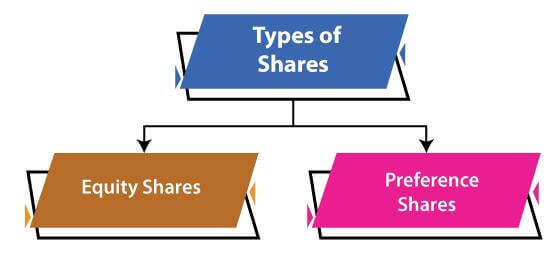Types of Shares

What are Shares?
The total capital of a company is divided into units of small denominations which are known as shares. In other words, a share is a unit of ownership of a company. The person who buys the shares is called a shareholder. As a shareholder, he/she invests in the company and holds a percentage of ownership of the issuing company. This can be understood more clearly from the following example:
Example: A company has a total capital of Rs. 20,00,000, which is divided into 1,00,000 units of Rs. 20 each. This each unit of Rs. 20 will be a share of the company. Thus, in this case, the total number of shares that the company holds is 1,00,000 of Rs. 20 each.
Types of Shares
There are two types of shares that a company can issue as per Section 43 of the Companies Act, 2013. They include the following:

1. Equity Shares
Those shares which offer the dividends only if the profit is left after making the payment of dividends to the preference shareholders at a fixed rate are known as equity shares. In other words, equity shares do not provide a fixed rate of dividend to the shareholders. If the profit is high then the dividend can be high and vice versa. In case there is no profit in any year, then these shareholders do not get any dividend. Regarding the return of capital, the capital of these shares is returned only after the full payment of preference shares' capital. These shareholders have voting rights and they control the affairs of the company. Equity shareholders are called the actual owners of the company.
On the Basis of Definition
-
Bonus Shares
Bonus shares are those shares that are issued to the existing shareholders free of cost as a dividend or in the form of the bonus to:
- Capitalize a part of the retained earnings of the company,
- Convert the company's share premium account, or
- Distribute the Treasury bill.
An important point about bonus shares is that the issue of these shares increases the total number of shares issued by the company and owned by the shareholders but it does not bring any change in the value of the company.
-
Rights Shares
Rights shares are those new shares that are offered to the existing shareholders at a particular price that is lower than the market price within a specific period. These shares can be offered for trading in stock markets only after the existing shareholders reject to buy them. Issuing the rights shares is the fastest way for the company to raise capital. Two types of rights shares are Direct Rights Shares and Standby or Insured Rights Shares.
-
Sweat Equity Shares
Sweat equity shares are those shares that are issued to an employee or director who has given an extraordinary contribution towards a business venture or project. Here, this contribution is not related to the monetary terms rather it is the contribution of an individual in form of the physical labor, mental effort, and time.
-
Non-voting Shares
Generally, most of the equity shareholders have voting rights but the company can make an exception by issuing differential or zero voting rights shares. The price of non-voting shares is less than the price of the voting shares.
On the Basis of Returns
-
Dividend Shares
The new shares which are issued on a pro-rata basis by the company to pay the dividends of the existing shareholders are known as the dividend shares.
-
Growth Shares
These shares are associated with companies that have very high growth rates. These companies rarely distribute dividends and keep the profit in the form of retained earnings to invest in the projects which accelerate the growth of the company. The value of their shares increases rapidly in the market thereby these companies give priority to provide capital gains to the shareholders instead of dividends.
-
Value Shares
Value shares are traded in the stock markets at a price that is lower than their intrinsic value. These shares have a high dividend yield, low P/B ratio, and low P/E ratio. People invest in these shares with the expectation of rising in price over a while, thus making them available with a better price of the shares. Value shares represent the company's performance in the marketplace.
2. Preference Shares
Preference shares are those shares that provide the following two rights to the shareholders:
- These shares give the right of receiving dividend at a fixed rate to the shareholders before it is distributed among the equity shareholders. In short, preference shares have priority over equity shares in case of receiving the dividend.
- These shares also have the right to return capital before equity shares when a company is wounded up.
Other than the rights given above, preference shares may offer some additional rights to the shareholders. But these additional rights are depending on the type of preference shares. Generally, there are eight types which include the following:
-
Cumulative Preference Shares
Those preference shares give the right to recover the arrears of preference dividend to shareholders before the payment of any dividend to the equity shareholders. This means, if the cumulative preference shareholder does not get a dividend in any year due to any reason then the dividend keeps on accumulating until the full payment is not done. For example, on 8% cumulative preference shares, the company did not pay the dividend for the year ending 31st march 2019 and 2020. Now, if the company wants to distribute dividends among equity shareholders for the year ending 31st March 2021, the cumulative preference shareholders will get the priority over equity shareholders and they will get a total of 24% dividend (for the years 2019, 2020, and 2021). And after that, if any profit is left then the payment of the dividend is made to the equity shareholders. These arrears of dividend are presented as a Commitment under 'Contingent Liabilities and Commitments' in the balance sheet.
-
Non-cumulative Preference Shares
Such types of preference shares provide a fixed amount of dividend out of the profits each year to the shareholders. If the company does not declare dividends in any year due to any reason then non-cumulative preference shares do not get anything and they can't even claim for the unpaid dividend in any subsequent year.
-
Participating Preference Shares
These shareholders get a right to participate in the surplus profits if any left after paying dividends to the equity shareholders at a stipulated rate. Other than this additional dividend, these shareholders get a fixed preference dividend every year as per the pre-decided terms. Similarly, in the event of winding up of the company, participating preference shareholders are entitled to enjoy a predetermined proportion of surplus but only after paying back both the equity and preference shareholders and if any surplus is left after their payment.
-
Non-participating Preference Shares
Such shareholders get only a fixed and pre-decided rate of dividend every year. As clear from the name, these shareholders do not have the right to participate in the surplus profits or in any surplus at the time of winding up of the company. Usually, preference shareholders do not get any right in the company's surplus unless expressly provided.
-
Redeemable Preference Shares
These are the preference shares for which the company makes a repayment within a stipulated period as per the terms of the issue. Also, there is the fulfillment of certain conditions which are stated in Section 55 of the Company Act 2013 required for the repayment.
-
Irredeemable Preference Shares
Those preference shares which can't be redeemed or the capital of which can't be refunded before the winding up of the company are known as irredeemable preference shares. But as per Section 55 of the Companies Act 2013, a company limited by shares can't issue any preference share which is irredeemable or can be redeemed after the expiry of 20 years calculating from the date of issue of shares.
-
Convertible Preference Shares
When the holders of preference shares can convert their shares into equity shares at their option as per the terms of the issue then such shares are known as convertible preference shares.
-
Non-convertible Preference Shares
When the holders of preference shares do not have the right to convert their shares into equity shares then such shares are known as non-convertible preference shares.
|


 For Videos Join Our Youtube Channel: Join Now
For Videos Join Our Youtube Channel: Join Now










